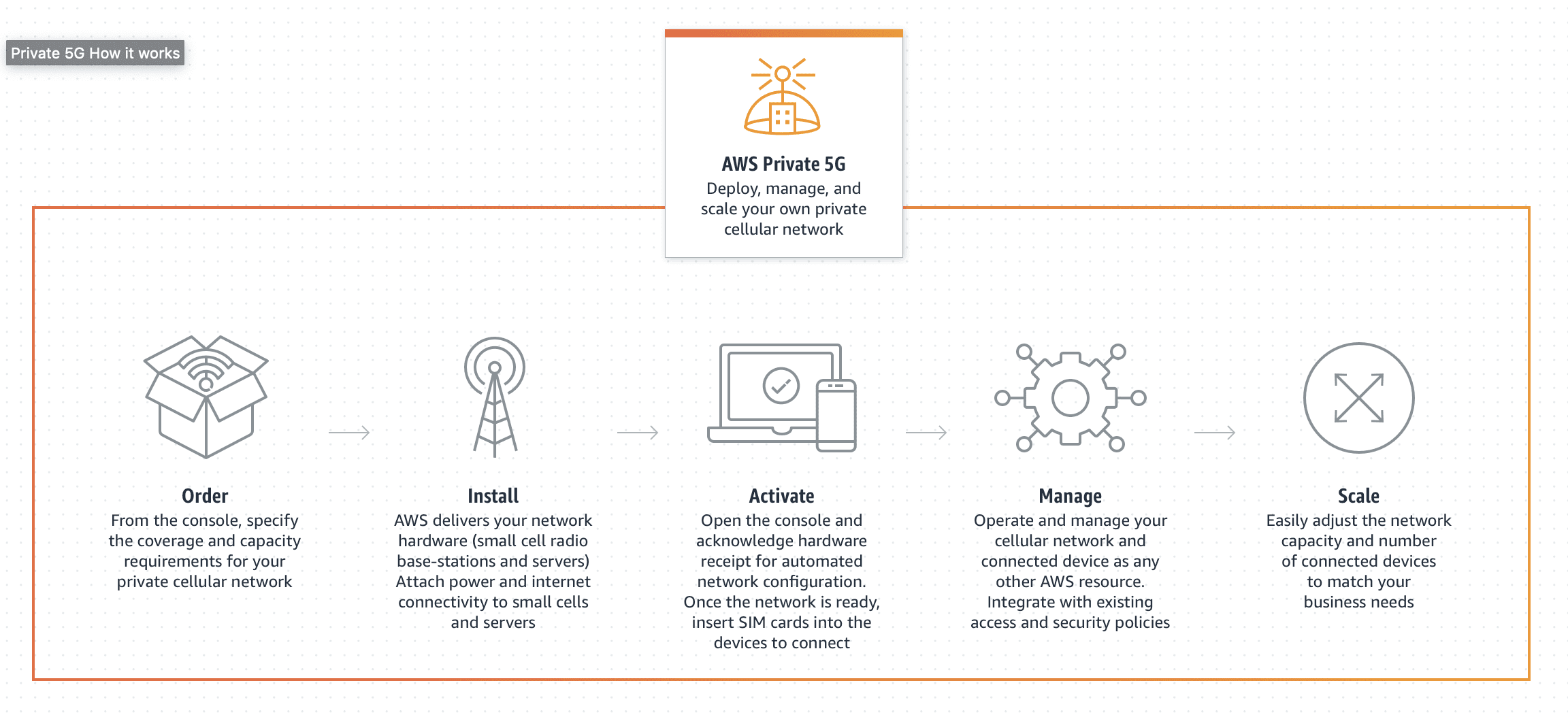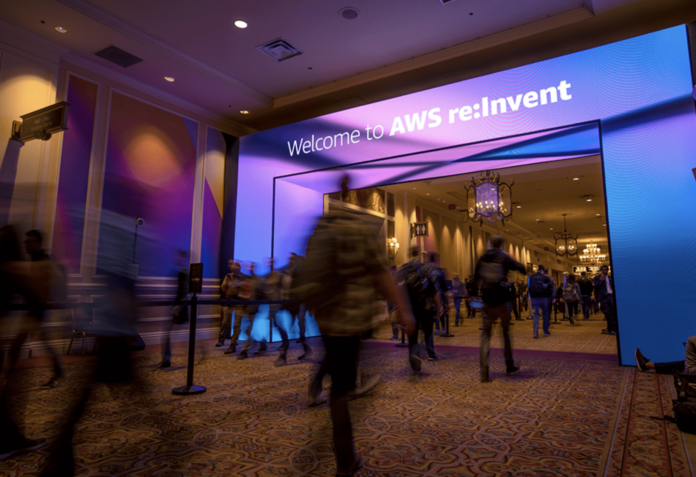Big news in the excitable private 5G universe; Amazon Web Services (AWS) has introduced its own private 5G service, AWS Private 5G, incorporating small cell radio access network (RAN) units, core and RAN software, and subscriber identity modules (SIM cards), plus sundry edge servers and edge-cloud resources to run everything on. There was no word, at the announcement, about its partners for the 5G componentry, or whether they will be visible and optional to enterprise customers.
There was no word, either, on spectrum access systems (SAS) in the US, for private or shared usage of the CBRS band, nor of whether the service incorporates public 5G network infrastructure at any point, including for core network hosting or multi-access edge compute (MEC) reserves – on which AWS is working with a bunch of prominent tier-one public carriers across the globe.
AWS works with Mavenir on RAN, Athonet on core network, and Federated Wireless on SAS frequency coordination in CBRS; the first and last are on its books, and the second has been written about in these pages. There are others, too. US-based RAN provider JMA Wireless (JMA) announced earlier this month (November) it had installed a private LTE network for Carnegie Mellon University, using AWS for edge-cloud functions and a core network from Druid Software.
But the partners aligned by AWS for its new plug-and-play pay-as-you-go private 5G service have not been revealed, as yet; when asked, AWS refused to comment. Nevertheless, the Bellevue-based hyperscaler, arguably more than Microsoft / Azure (Microsoft has acquired Metaswitch and Affirmed Networks in recent times, ostensibly to offer core 5G networking to enterprises and operators, respectively), and sooner than Google Cloud, has put clear focus on a partnership ‘ecosystem’, as well as co-creation, to drive both enterprise and carrier workloads to its edge/cloud.
Its co-creation shtick, trendy in the Industry 4.0 space, is notable in its MEC adventures with the likes of Verizon and Vodafone. It is unclear, as well, how the offer, presented as a managed service, will play beyond CBRS allocations in the US, with various vertical spectrum provisions in industrial markets in France, Germany, Japan, and the UK, among others. As it stands, the launch looks like a soft one, focused on standalone setups in CBRS in the US.
AWS announced three customers, including itself. These are DISH Network, Amazon Fulfillment, and Koch Global Services. The latter has locations in nearly every US state, and 60 countries besides, and runs companies engaged with “food, clothing, water, transportation, and technology”. In a supplied quote, it tied the new AWS Private 5G offer in with both Mavenir and (apparently) public mobile operators (“global communication service providers”).
Matt Hoag, chief technology officer at Koch, said: “Koch sees great potential in private 5G [but] there are significant challenges in the do-it-yourself approach. In collaboration with industry software vendors like Mavenir and global communication service providers, AWS Private 5G can help solve real challenges that enterprises face in deploying private cellular networks around the world. This combination will also encourage expansion of the cellular industrial IoT ecosystem and accelerate the delivery of disruptive private connectivity solutions for our customers.”
DISH Network, the fourth largest operator in the US, made waves among traditional telcos in April when it said it would port all its network infrastructure, bar physical radio masts, onto the AWS cloud, compromising some of the old ground held by the likes of Nokia, Ericsson (and Huawei). Amazon Fulfillment, the other first-wave customer, runs warehouses (“Fulfilment Centers”, or FCs) – which “store products”, and pick and pack them when orders are placed, and are filled with robots, scanning machines, and computer systems.
All three are taking the AWS Private 5G, the story goes, and have built dedicated on-site private networks at their facilities in “days instead of months”. That is the promise from AWS; that private 5G can be as quick and easy as ordering from its website. “With just a few clicks in the AWS console, customers specify where they want to build… and the network capacity for their devices – and AWS delivers and maintains [all the private 5G parts],” it said.
Setup and deployment is automated, it said, and scales capacity “on demand” to support additional devices and network traffic. It stated: “There are no upfront fees or per-device costs with AWS Private 5G, and customers only pay for the network capacity and throughput they request.” AWS delivers and maintains the pre-integrated radio units, servers, core and RAN software, and SIM cards.
No need to search out, gamble on, and negotiate with “multiple third-party vendors”, it said. Once the settings are defined, and the bits and pieces are delivered, AWS automatically configures and deploys the mobile network. Like a Wi-Fi hotspot, the messaging suggests. “To connect devices to the private network, customers simply plug the AWS-supplied SIM cards into their devices.”
AWS stated: “Today, most private network deployments require customers to invest considerable time, money, and effort to design for anticipated peak capacity and to procure and integrate software and hardware components from multiple vendors. Once the network is installed, customers have to undertake another lengthy procurement process to increase network capacity if the devices or network traffic grows beyond the capacity the network can handle.
“Customers also have to manage different security policies and systems for each type of device connected to a private mobile network, which makes integration with IT management systems difficult. Even if customers are able to get the network running, current pricing models charge for each connected device and make it cost prohibitive for use cases that involve thousands of connected devices.”
Sounds rubbish, right? “As a result, most enterprises are unable to deploy and operate private mobile networks,” it goes on. Sounds dreamy, right?“AWS Private 5G integrates with AWS Identity and Access Management (IAM) enabling network administrators to directly control which resources mobile devices can access on their private mobile networks,” it said.

“Customers can start with small networks with fewer devices using AWS Private 5G, analyze network needs once in operation, and leverage the elasticity and pay-as-you-go pricing of AWS to scale their private mobile network as they add more devices… Customers can quickly deploy and manage private 5G networks without the challenge of procuring, scaling, and maintaining equipment or worrying about add(ing) additional capacity.”
David Brown, vice president of EC2 at AWS, the unit in charge of elastic compute (EC2), said: “Many of our customers want to leverage the power of 5G to establish their own private networks on premises, but they tell us that the current approaches make it time-consuming, difficult, and expensive to set up and deploy private networks. With AWS Private 5G, we’re extending hybrid infrastructure to customers’ 5G networks to make it simple, quick, and inexpensive to set up a private 5G network. Customers can start small and scale on-demand, pay as they go, and monitor and manage their network from the AWS console.”
Quotes from the first customers were in-line. Stephen Bye, chief commercial officer at DISH, said: “AWS has enabled us to onboard and scale our 5G core network functions within the cloud. [It is] a key strategic partner in helping us deliver private enterprise networks to our customers… Private 5G networks allow us to give customers the scale, resilience, and security to support a variety of devices and services, unlocking the potential of Industry 4.0.”
Jeff Armstrong, director of infrastructure engineering at Amazon, said: “We deploy technology outside of FCs to make moving tractor trailers around safer and more accurate and efficient. We have to provide network services for these systems across millions of square feet of outdoor space. Previously, to get proper Wi-Fi coverage in the parking lots around our FCs, we had to add light poles for the Wi-Fi equipment, modify our outdoor electrical systems and either trench fiber or support Mesh systems.
“This was expensive, disrupted productivity during installation, and had a high support burden. With AWS Private 5G, we can use two outdoor small cells mounted on the corners of our warehouses and achieve additional coverage in our parking lots, which was much quicker and cheaper to deploy. Just as important, we will be able to scale up our AWS Private 5G deployment as we expand our facilities.”
There is more on the AWS Private 5G story here.
Enterprise IoT Insights and RCR Wireless are holding a free webinar this Thursday (December 9) with Google Cloud on: The Role of Hyperscalers in 5G and Edge. The session – at 8am PT / 11am ET / 4pm GMT / 5PM CET – also features panellists from AT&T and Telecom Argentina. To attend, sign up here, or click on the image below.


